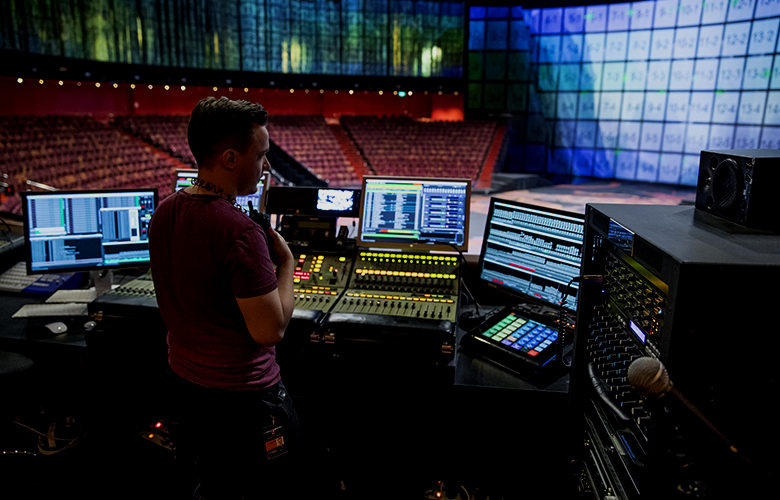
Let’s get one thing perfectly straight. There is not one single large-scale (or small-scale for that matter) theatrical system that has ever been created equal, but there is one thing that all system must have in common. The fact of this commonality between them is that when they fault or fail, any one of them can bring a show to a halt and if you’re not quick enough, it can even bring a perfect show to a swift and unexpected conclusion.
It can be agreed that it doesn’t matter the type of system in question, that each individual system has its own ability to bring a show to its knees. It can be lights, sounds, automation, rigging, special effects, or even base building. I am sure that a technician from each one of these departments can give you a perfectly good example of how a show stop or loss could occur within their particular department’s system. However, the scope of this article is not to debate whose systems are the most important to a performance or which ones are the most vulnerable to failure, yet the topic is how to get to the root cause of a fault or failure within a given designated period of time.
How much time do you have? What tasks need to be accomplished within that given period of time? Which method of troubleshooting is the fastest? What equipment is required? What tools do you have at your disposal? What kind of training is required for finding and fixing your problems fast?
Most, if not all, theatrical systems have the ability to fault or fail in a non-damaging, non-threatening or non-catastrophic fashion prior to having to pause or stop a show. In fact, this is generally a required specification for any installation tender package. For example, if during a scene, one out of a few hundred intelligent lights, lamps off without warning, then there is a good chance that the technicians are going to have at least a few minutes to try and re-strike the bulb prior to needing that mover again for the next scene. However, if that mover is being used for a special or when the technician goes to re-lamp the mover and they happen to lose an entire section or even an entire rig of movers, well, the show just came to a complete stop and the time-clock starts. You better get troubleshooting and fast.
Most shows will also have a pre-determined amount of time that each team can troubleshoot their faulted or failed equipment prior to pulling the plug and playing the cancellation announcement. Each type of show and/or venue is going to have a different set of rules. Resident shows, touring shows, cruise ship cabaret shows and local theatre are all going to have different guidelines that are followed to determine how much time they have to find and fix their issue.
So how much time are we given, as technicians, to find, fix and test a show pausing component failure? A good guideline to follow is no longer than 30 minutes. Not much time is it?
During this unforgiving period of thirty minutes, any good technician worth their weight is going to be keeping an eye on their time and giving consistent updates on information regarding their progress to the Technical Director, Stage Manager or Front-of-House Manager. This merely depends on whom they are required to keep informed. Key points of information can be anything that is found to be pertinent to the situation, but it needs to be kept short. Don’t use 15 words, when 5 words will suffice. A few examples of information could be the fault being indicated, how much time is needed before the next update, or what is going to be required to test the fault condition.
There can be a few distinct advantages to giving updated information to those in need of the details. The largest advantage of information is putting others at ease that help is on the way. One of the best ways to do this is by identifying the fault and initial plan of action at an appropriate time, over the main communication channel. Giving the fault being indicated explains to other staff that you know what your problem is and you have it under control. This can put people at ease and give you a few extra ticks of the clock to dig deeper prior to your next update.
Time requests are the most important part of your update, so be sure to indicate the type of time you need. What kind of time requests are there? There is time needed to find the fault, time needed to correct the fault, time needed to circumvent the fault or even time needed to test the system after the fault has been rectified. It doesn’t matter really the type of time you’re asking for, but the one important rule you must follow when asking for time is to be consistent. Don’t ask for 3 minutes when you need 20.
Most technical directors will stay off of your back and will defend you from other departments pressing for additional information, during this requested time period. However, if extended time periods are continuously requested, people lose patience, quickly. Technicians should always do themselves a favor and always give themselves a time buffer. Any fault is going to take longer to identify and repair than originally anticipated, so a few additional minutes should be added on to their original estimate. Be realistic and don’t get greedy. If you need it, great, use it. If you don’t need it, even better, you look like a champion. However, if you ask for too much, the show is already over. Remember, the squeaky wheel gets the grease, but if the wheel squeaks too much they will just replace the wheel. In this case, the squeaks are your time requests and they need to be accurate, realistic and kept to a minimum. So give yourself some room to move and more importantly, think.
Don’t forget about testing. It is extremely easy in the heat of the moment to forget that even though you have a system back online, you still need to test it. The only thing worse than having a show stop in the first place due to a failed component is having to stop the show again, only because the failed piece of equipment wasn’t fixed properly during the first show pause. This won’t make your superiors or your patrons very happy, to say the least. Stop, take your time and do it right the first time. In order to do this, it is important to remember that testing is just as important as finding and repairing.
There are many different methods and skills that can be used to troubleshoot an entire system or failed piece of equipment, however, depending on your time constraints there are 7 steps in particular that can get you to the bottom of your issue faster than you ever expected. Now don’t be fooled or naïve, as in the words of Richard Hamming, “Luck favors the prepared mind.” Each one of these steps are not going to be useful at the time of the event. Each one of these steps can take days, week, months or even years to prepare for, but once you are prepared, when a fault occurs, you will be ready.
Continue to Troubleshooting Your Theatrical Systems: Part 2
Also By Jay Withee:
12 Tips On Managing A Technical Team In Live Entertainment
Join TheatreArtLife to access unlimited articles, our global career center, discussion forums, and professional development resource guide. Your investment will help us continue to ignite connections across the globe in live entertainment and build this community for industry professionals. Learn more about our subscription plans.
Love to write or have something to say? Become a contributor with TheatreArtLife. Join our community of industry leaders working in artistic, creative, and technical roles across the globe. Visit our CONTRIBUTE page to learn more or submit an article.


Jay Withee has had an interesting and multifaceted 20-year career in the entertainment and theatre industry working with companies such as TAIT, Cirque Du Soleil and Dragone. Currently, Jay is the Head of Services & Support – Asia for TAIT in Hong Kong. Prior to joining TAIT in 2019 as a Controls Engineer, Jay was the Technical Show Manager with Dragone at The House of Dancing Water at the City of Dreams Resort in Macau. At The House of Dancing Water, Jay held the roles of Automation Operator, Lead Automation Operator, Assistant Head of Automation, Head of Automation and Deputy Technical Director. Jay had been involved with The House of Dancing Water since its installation and creation, enjoying all the complexities that were involved in bringing this large-scale production to life and operating it on a day-to-day basis. He has been involved with other creations of similar scale including Cirque du Soleil’s KA at the MGM Grand in Las Vegas. Jay started his technical career working for the cruise industry, spending almost five years on the ships. In this time, he held the position of Automation Technician, Field Service Engineer and Rigging Specialist, while getting the opportunity to assist on some of the largest theatrical installations sailing the high seas today, including Royal Caribbean’s Liberty and Independence of the Seas. A graduate of ECPI University, Jay earned his Bachelor of Science in Electronic Engineering with a major in Mechatronics. In his spare time, Jay has chaired the Entertainment Technology division of the Professional Advisory Board for St. Clair College in Windsor, Ontario, Canada and been a member of the Industry Expert Advisory Group for Millersville University in Millersville, Pennsylvania. Jay has also had the opportunity of being part of the TheatreArtLife start-up team. Jay lives in Hong Kong with his wife Anna and two kids, Tyler and India.
Read Full Profile© 2021 TheatreArtLife. All rights reserved.

Thank you so much for reading, but you have now reached your free article limit for this month.
Our contributors are currently writing more articles for you to enjoy.
To keep reading, all you have to do is become a subscriber and then you can read unlimited articles anytime.
Your investment will help us continue to ignite connections across the globe in live entertainment and build this community for industry professionals.